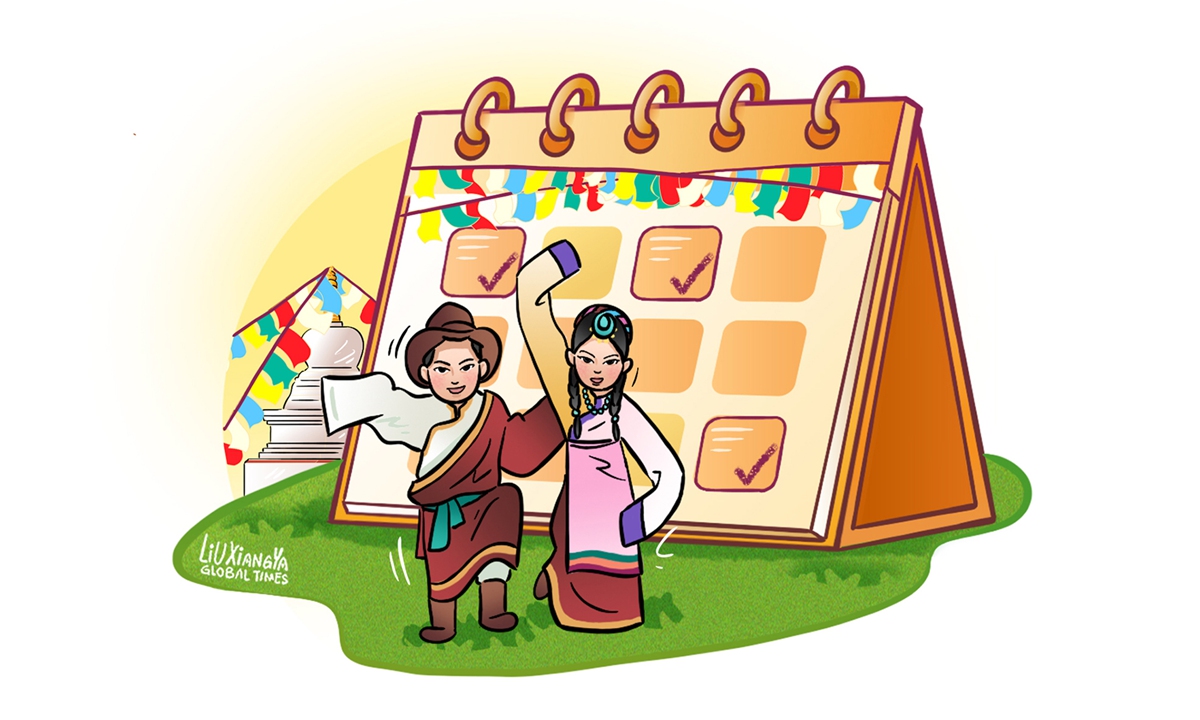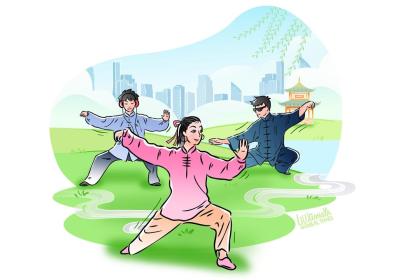
Illustration: Liu Xiangya/Global Times
In terms of time itself, this second and the next, this day and that day, are no different. However, for the bustling multitude of sentient beings, there is always some reluctance. Festivals are a game between humanity and time. Time is relentless, yet people insist on snatching a few days from these indifferent days, using them for prayer, commemoration, or revelry. And the celebration of a new year is the most fruitful result we obtain in this ancient game.
People living in Southwest China's Xizang Autonomous Region, whether they are Tibetan, Han, or members of other ethnic minorities, are the winners in this game. Before them lie stacks of chips won from time, thick and substantial.
Every deep autumn, amid the envious gazes of onlookers, the people of Xizang embark on the long "New Year season." The first to arrive is the Losar celebration in the region of Gongbu (present-day Nyingchi).
Legend has it that a long time ago, the region faced an invasion by foreign enemies. The people of Gongbu, in order to defend their homeland, formed an army to support the cause. As they set out on their journey, it happened to be the ninth month of the Tibetan calendar. The soldiers were fearless in the face of the impending battle, with their only regret being the inability to drink barley wine, indulge in festive snacks, and bask in the New Year's fire of pine branches.
In a surprising yet logical move, the people of Gongbu decided to advance the Tibetan New Year to the first day of the 10th month, allowing the soldiers to set out without hesitation. In commemoration of the brave soldiers who volunteered for duty that year, every first day of the 10th month, the people of Gongbu offer sacrifices and keep vigil in honor of these soldiers. Over time, the tradition of celebrating the Gongbu New Year on the first day of the 10th month took shape.
In the Gongbu New Year celebration, the first to be treated is not a human but a canine companion. The people of Gongbu arrange New Year's food neatly on wooden plates or long wooden boards. There are
zanba (roasted barley flour dough) balls, as well as meat from cattle, sheep and pigs.
Additionally, there are peaches, walnuts, butter, buttermilk, ginseng fruits, barley wine, and more. Tea and alcohol are served in walnut shells, all prepared meticulously. The host calls the family dog politely, saying, "Comfortable dog, joyful dog, please come and dine!" This is repeated three times before the dog starts eating.
It is said that experienced dogs exhibit great dignity at this moment, sniffing all the food before deciding what to eat. Some dogs, however, may bark wildly, overturn plates, and spill tea and alcohol. The host considers this behavior as inauspicious and promptly drives away the "ungrateful guest."
The people of Gongbu believe that whether a dog eats something or not is a divine indication. Therefore, the entire family watches the dog's every move closely. If the dog eats
zanba or cakes, it is seen as a sign of a good harvest. If it consumes butter or buttermilk, it is considered an omen of prosperous agriculture.
The New Year is indeed such a game, where all sorts of interesting things can happen, and an auspicious explanation can be derived for each.
However, the Gongbu New Year is just the beginning.
In the Tibetan calendar, there are, in fact, four New Year days. Apart from the Gongbu New Year, there is the Burang New Year in the Ngari Prefecture on the first day of the 11th month of the Tibetan calendar, while the New Year in the Xigaze Prefecture falls on the first day of the 12th month. The areas mainly centered around Lhasa, on the other hand, welcome the traditional Tibetan New Year on the first day of the first month of the Tibetan calendar.
In summary, each region has its reasons for altering the timing of the "New Year" event. However, the Tibetan people only adjust, never miss it. In their life philosophy, trouble and joy are never a simple exchange of one for the other. More difficulties only motivate them to explore and gain happiness.
Next is
yuan dan - the gregorian New Year's Day. This is a statutory holiday throughout China and the globally celebrated New Year. People living in Xizang certainly do not miss out on the celebrations. They gather in the most bustling areas of the city, count down loudly, release balloons, and remind each other that the year on official documents is about to change.
Since the era of reform and opening-up, many cities in Xizang have become more international, and the Tibetan people increasingly enjoy welcoming the New Year together with the rest of the world.
As the weather becomes colder, Lhasa becomes livelier. The Chinese New Year (Spring Festival) and the Tibetan New Year in the Lhasa region approach one after another. These festivals in Xizang are shared by all the people in the region, regardless of whether they are Han, Tibetan, or belong to other ethnic groups.
Sometimes, Spring Festival and the Tibetan New Year coincide at the same time. Guess what? Not a single day of holiday time is missed! They are accumulated and used together. The 14 consecutive days of paid leave turn Xizang into a true paradise on earth.
The numerous festivals not only bring a cheerful atmosphere but also signify ample holidays. For many couples living in various cities around China, the seven-day holiday during the Chinese New Year is very busy and intense. They must schedule time to visit both their hometowns to see each other's parents, complete a series of visits to relatives and friends, and also entertain their children. So, every year, the Spring Festival holidays feel like a battle.
However, Liu Li and Baima Yangzhen are always winners. They choose to spend the three-day Gongbu New Year in Nyingchi to visit Baima Yangzhen's parents, then use the seven-day Spring Festival holiday to return to Liu Li's hometown in Shaanxi to visit his parents. The subsequent Tibetan New Year is used to fulfill some promises to their daughter.
The Xizang Autonomous Region boasts an enviable duration of holidays on a global scale. In addition to the public holidays that all Chinese people share, there are at least an additional 75 days of extra holidays in Xizang region.
In such a diverse and multi-ethnic community, coupled with ample holidays, people can leisurely experience the New Year customs passed down from each ethnic group through generations. The Han people may participate in their Tibetan friends' ghost-exorcising evening, while the Tibetans may be found at home making dumplings and enjoying hot pot.
The reality is that all of this unfolds in an incredibly natural manner. People not only gain a deeper understanding of each other through relaxed jokes and dances but also learn about the distant history, from which their respective traditions originated.
The author is a lecturer at Hunan University and holds a PhD from Renmin University of China. [email protected] 





